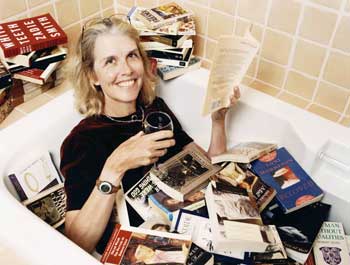![[Metroactive Books]](/gifs/books468.gif)
[ Books Index | Santa Cruz | Metroactive Home | Archives ]
100 Ways to Load Your Library
Jane Smiley offers more than '13 Ways of Looking at the Novel'—she offers her thoughts on 100 novels
By Rick Kleffel
Smiley clearly knows about novels from the inside out, as she's demonstrated with works such as A Thousand Acres and Horse Heaven. But in the wake of 9/11, Smiley felt her own focus falter. "I think now, I look back and I was more stunned than I realized, like everybody else, probably. And so what I did was I decided to read the most remote possible novel I could find, and that was The Tale of Genji ... which was distributed in the year 1004. But I didn't find it remote at all, I found it actually quite relevant. ... So I decided that maybe it was time to read a lot of books and gel in my mind what their similarities were." She decided to do something many readers have promised to do: read 100 novels.
Not only did she keep her promise, she went further. She did exactly what every reader might hope Jane Smiley would do. She wrote about it. In 13 Ways of Looking at the Novel (Knopf; 608 page; $26.95 cloth), she writes not only about the 100 novels she read, but also about the idea of the novel itself. She starts the book asking and answering a deceptively simple question: "What is a novel?" She concludes with 100 essays on each of the books she read to answer that question for herself. Her journey is a captivating look at reading, at readers, at writing, and at books.
Thirteen Ways of Looking at the Novel is divided into two sections. In the first portion of the book, Smiley describes the novel itself, from the abstract idea of the novelist to its history, psychology, art and morality. "I pretty much knew I was going to write that chapter about morality, because so many novels from the 18th century were about subjects that we would call immoral," she says of her work. But writing about the novel proved to be as intuitive an experience as writing a novel. "The chapter 'The Circle of the Novel,' which is a way that I organize novels—that came later, as a revelation. I think I was on a plane somewhere and I thought, 'Aha!'" It will come as no revelation to readers that Smiley's circle and, indeed, her entire prose journey are every bit as gripping as any novel she's written.
But she doesn't expect readers to pick up Thirteen Ways of Looking at the Novel and read it cover to cover. It's hard to resist dipping into her series of 100 essays and finding out what she has to say about your own favorites.
"I started the list the way you always start a big project," she tells us. "I went out and bought a whole bunch of books and I lined them up. I had that retail pleasure." Anyone who has ever bought "a bunch of books" will know exactly how she felt, and you can expect to find that happening often as you read this book. "I can't say that devising the list became a problem or a dilemma. But I could have had 200 books on the list."
And what a list. This is a reader's buffet, and Smiley expects readers to make their own choices. "I expect them to dive in here and there. If they're writing a novel, I expect them to read the two chapters on novel writing first. If they have an extensive library, I expect them to dip into the back section first, and see what I have to say about particular books. ...You could wander around in this book."
Reading is, as ever, the operative term. "To read," Smiley concludes, "is to experience freedom. We know that, because reading is one of the things that's proscribed in countries that are very unfree." She knows her list might be controversial. "There could be any amount of controversy about any list," she reminds us. "But what you should remember is that all this controversy is a luxury, and you should be grateful for it."
[ Santa Cruz | Metroactive Central | Archives ]
Copyright © 2005 Metro Publishing Inc. Maintained by Boulevards New Media.
For more information about Santa Cruz, visit santacruz.com.
![]()

Haute Tub Amazingly, Jane Smiley has never been photographed frowning.
Jane Smiley will be appearing Friday, Oct. 7, at 7:30pm at Bookshop Santa Cruz, 1520 Pacific Ave.; 831.423.0900.
From the October 5-12, 2005 issue of Metro Santa Cruz.